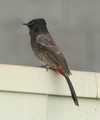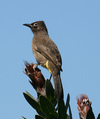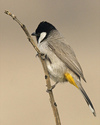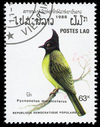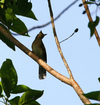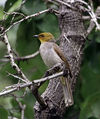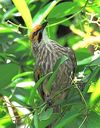Genus Pycnonotus

Black-headed Bulbul - Pycnonotus atriceps
Sooty-headed Bulbul - Pycnonotus aurigaster
Dark-capped Bulbul - The bill is fairly short and straight. The bill, legs and feet are black and the eye is dark brown with a dark eye-ring, which is not readily visible.
Orange-spotted Bulbul - Its natural habitats are subtropical or tropical moist lowland forests and subtropical or tropical moist montanes.
Red-eyed Bulbul - The Red-eyed Bulbul is a species of songbird in the Pycnonotidae family. It is found in Brunei, Indonesia, Malaysia, Burma, Singapore, and Thailand. Its natural habitat is subtropical or tropical moist lowland forests.
Red-vented bulbul - The Red-vented Bulbul is a member of the bulbul family of passerine birds. It is resident breeder in tropical southern Asia from India and Sri Lanka east to Burma and southwestern China. It has been introduced and has established itself in the wild in many Pacific islands including Fiji, Samoa, Tonga, and Hawaii. It has also established itself in parts of Dubai, the United Arab Emirates and New Zealand. It is included among the world's worst invasive alien species.
Cape Bulbul - The Cape Bulbul is 19–21 cm long, mainly dull, blackish brown with a diagnostic white eye-ring, and yellow undertail coverts. The head has a small crest. The short, straight bill, legs and feet are black and the iris is dark brown. The sexes are similar in plumage.
Flavescent Bulbul - The Flavescent Bulbul is a species of songbird in the Pycnonotidae family. Its name comes from flavescent, a yellowish colour. It is found in Bangladesh, China, India, Indonesia, Laos, Malaysia, Burma, Thailand, and Vietnam. Its natural habitat is subtropical or tropical moist montanes.
Yellow-vented Bulbul - It is found in a wide variety of open habitats, but not deep forest. It is one of the most common birds in cultivated areas. They appear to be nomadic, roaming from place to place regularly.
Red-whiskered bulbul - The Red-whiskered Bulbul is a passerine bird found in Asia. It is a member of the bulbul family. It is a resident frugivore found mainly in tropical Asia. It has been introduced in many tropical areas of the world where populations have established themselves. It feeds on fruits and small insects and they conspicuously perch on trees and their calls are a loud three or four note call. The distinctive crest and the red-vent and whiskers makes them easy to identify. They are very common in hill forests and urban gardens within its range.
Himalayan Bulbul - It is found in Afghanistan, Bhutan, India, Nepal, Pakistan, Iraq, Tajikistan, and Saudi Arabia.
Cream-striped Bulbul - Its natural habitats are subtropical or tropical moist lowland forests and subtropical or tropical moist montanes.
White-eared Bulbul - This species is very similar in appearance to the Himalayan White-cheeked Bulbul Pycnonotus leucogenys but smaller and uncrested and with a larger white cheek patch. It has a pale bare eye-ring. The vent is orange yellow. Sexes are alike.
White-browed Bulbul - This is a bird of dry scrub and woodland edges. It builds its nest in a tree; two eggs is a typical clutch.
Black-crested Bulbul - This is a bird of forest and dense scrub. It builds its nest in a bush; two to four eggs is a typical clutch. The Black-crested Bulbul feeds on fruit and insects.
Black-and-white Bulbul - The Black-and-white Bulbul is a species of songbird in the Pycnonotidae family. It is found in Brunei, Indonesia, Malaysia, Singapore, and Thailand. Its natural habitats are subtropical or tropical moist lowland forests and subtropical or tropical moist montanes. It is threatened by habitat loss.
Blue-wattled Bulbul - It is found in Brunei and Indonesia. Its natural habitat is subtropical or tropical moist lowland forests.
Yellow-tufted Bulbul - This is a bird of jungle and wooded farmland. Despite its restricted range, it is quite readily found at sites such as Horton Plains and Victoria Park in Nuwara Eliya. It builds its nest in a bush; two eggs is a typical clutch.
Grey-headed Bulbul - The Grey-headed Bulbul is a member of the bulbul family of passerine birds. It is endemic to the Western Ghats of south-west India, found from Goa south to Tamil Nadu, at altitudes up to 1200m. It is found in dense reeds or thickets mainly near rivers and swampy areas inside forests. They have a distinctive call that reveals their presence inside dense vegetation that makes them hard to spot. Their taxonomic position within the bulbuls is not clear.
White-eyed Brown Bulbul - The Cream-vented Bulbul is a species of songbird in the Pycnonotidae family. It is found in Brunei, Indonesia, Malaysia, Singapore, and Thailand. Its natural habitat is subtropical or tropical moist lowland forests.
Light-vented Bulbul - The particular characteristic is the large white patch covering the nape and the sides of its black head. It also sings very brightly and variably with a 'cha-ko-lee...cha-ko-lee...' sound.
Striated Bulbul - It is found in Bhutan, China, India, Laos, Burma, Nepal, Thailand, and Vietnam. Its natural habitat is subtropical or tropical moist montane forests.
Formosan Bulbul - The Taiwan Bulbul or Styan's Bulbul Pycnonotus taivanus is an endemic species of bulbul that lives in eastern and southern Taiwan. Though common in some areas, it has been listed as a species vulnerable to extinction. Its decline has been caused by habitat destruction and hybridisation with the closely related Light-vented Bulbul Pycnonotus sinensis; the two species ranges overlap in several areas, and Light-vented Bulbuls are also released for Buddhist ceremonies.
Spot-necked Bulbul - Its natural habitats are subtropical or tropical moist lowland forests and subtropical or tropical moist montanes. It is threatened by habitat loss.
Yellow-wattled Bulbul - Its natural habitat is subtropical or tropical moist lowland forests.
Yellow-throated Bulbul - The Yellow-throated Bulbul is a species of bulbul endemic to southern peninsular India. They are found on scrub habitats on steep, rocky hills many of which are threatened by granite quarrying. It is confusable only with the White-browed Bulbul with which its range overlaps but is distinctively yellow on the head and throat apart from the yellow vent. The calls of this species are very similar to that of the White-browed Bulbul.
White-spectacled Bulbul - Both sexes are similar; juveniles have a browner hood and less obvious eye-rings than the adults. The nest -a small cup of thin twigs, grass stems, leaves and moss- is generally located in bushes and lined with hair, shredded bark and small roots.
Anderson's Bulbul - It is found in China, Hong Kong, Laos, Burma, Thailand, and Vietnam.




